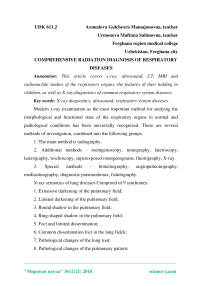Comprehensive radiation diagnosis of respiratory diseases
Автор: Axmedova Gulchexra Mamajonovna, Urmonova Maftuna Salimovna
Журнал: Мировая наука @science-j
Рубрика: Основной раздел
Статья в выпуске: 12 (21), 2018 года.
Бесплатный доступ
This article covers x-ray, ultrasound, CT, MRI and radionuclide studies of the respiratory organs, the features of their holding in children, as well as X-ray diagnostics of common respiratory system diseases.
X-ray diagnostics, ultrasound, respiratory system diseases
Короткий адрес: https://sciup.org/140263239
IDR: 140263239
Текст научной статьи Comprehensive radiation diagnosis of respiratory diseases
Modern x-ray examination as the most important method for studying the morphological and functional state of the respiratory organs in normal and pathological conditions has been universally recognized. There are several methods of investigation, combined into the following groups:
-
1. The main method is radiography.
-
2. Additional methods - roentgenoscopy, tomography, lateroscopy, laterography, trochoscopy, superexposed roentgenograms, fluorography, X-ray.
-
3. Special methods - bronchography, angiopulmonography, mediastinography, diagnostic pneumothorax, fistulography.
X-ray semiotics of lung diseases Composed of 9 syndromes:
-
1. Extensive darkening of the pulmonary field;
-
2. Limited darkening of the pulmonary field;
-
3. Round shadow in the pulmonary field;
-
4. Ring-shaped shadow in the pulmonary field;
-
5. Foci and limited dissemination;
-
6. Common dissemination foci in the lung fields;
-
7. Pathological changes of the lung root;
-
8. Pathological changes of the pulmonary pattern;
-
9. Extensive clarification of the pulmonary field.
Radiodiagnosis of inflammatory, purulent and neoplastic lung diseases Pneumonia Focal pneumonia Focal bronchopneumonia is characterized by catarrhal inflammation of the lung tissue with the formation of exudate in the alveolar lumen. Infiltration sites of 0.5–1 cm in size may be located in one or several segments of the lung, less often bilaterally. One of the variants of focal pneumonia is a focal-drain form. In this form, individual areas of infiltration merge, forming a large, non-uniform in density lesion, often occupying a whole fraction and having a tendency to destruction. The root of the lung is expanded.
Segmental bronchopneumonia (mono- and polysegmental) are characterized by inflammation of the whole segment, the airiness of which is reduced due to the pronounced atelectatic component. Such pneumonia is often prone to a protracted course. The outcome of prolonged pneumonia can be fibrosis of lung tissue and bronchial deformities. Croupous pneumonia (usually pneumococcal) is characterized by hyperergic croupous inflammation, which has a cyclical course with phases of tide, red, then white heating and resolution. Inflammation has a lobar or sublobar spread involving the pleura. X-ray picture: onset of the disease - increased pulmonary pattern in the affected lobe, expansion of the corresponding lung root. The progression of the inflammatory process: foci of darkening of different sizes, unclearly outlined, gradually becoming more intense, rapidly increasing and merging with each other. In the stage of pronounced changes: intensive darkening of the greater part of the lung, with an uneven oiled contour along the propagation process, and vice versa, with a sharply defined edge, respectively, of the interlobar gap. Consolidation of the pleura.
Stage resolution: reducing the intensity of darkening, which becomes nonuniform. In the future, for 2 weeks, the blackout slowly resolves. Interstitial acute pneumonia is characterized by the development of mononuclear or plasma cell infiltration and the proliferation of interstitial lung tissue, focal or spread. Certain pathogens (viruses, pneumocystis, fungi, etc.) most often cause such pneumonia.
Chronic pneumonia. Radiographic signs: a sharp increase and deformation of the pulmonary pattern, the presence of cellular enlightenments, resembling a “honeycomb” pattern; focal blackouts, separate, unclearly outlined; consolidation of the pleura, its fusion. Deformation of the bronchial tree with the appearance of bronchiectasis. Chest deformity. The narrowing of the intercostal spaces, reducing the volume of the pulmonary field, the displacement of the mediastinum organs. P.Abscess of the lung. X-ray picture: onset of the disease -there are no typical symptoms. There is more or less intense darkening with uneven, sometimes blurry contours. The progression of the disease is a relatively more intense shadow area that has an irregular globular shape. Typical radiological signs of an abscess are detected after breaking through its contents into the bronchus. A limited enlightenment of semi-circular or oval shape appears - a cavity. Part of the cavity is intensely darkened due to the liquid contents forming the horizontal level. The level is maintained with any change in the position of the patient. The walls of the cavity at the beginning are uneven, then they become smoother and more clearly defined.
I.Pulmonary artery thromboembolism - one-sided depletion of the vascular pattern, zones of avascularization and the “stump” of the artery open are determined.
-
II. Exudative pleurisy - radiographic signs: determination of homogeneous intensive darkening in the area of the pulmonary sinuses and oblique fluid level, displacement of the mediastinal organs in a healthy direction. Pneumothorax -definition of the site of enlightenment in the field of sines
-
III. Tumors of the lungs: Primary lung cancer
-
1. Central form. X-ray picture depends on the nature of the tumor growth. With peribronchial growth - the expansion of the shadow of the root. Intensive darkening in the root zone, its outer contour is well delimited or uneven and indistinct. Endobronchial growth - hypoventilation, and then atelectasis of a segment, lobe, or even the entire lung. Offset median shadow in the affected side. The high position of the dome of the diaphragm.
-
2. Peripheral cancer. X-ray picture: intense darkening of a more or less rounded shape with uneven, often poly-cyclic contours; Shadow localization -peripheral parts of the lung. Charge "path" connecting pathological shadow with the root of the lung.
-
IV. Cysts of the lung - a cyst filled with air, is defined as a thin annular shadow within which there is no pulmonary pattern. Filled with liquid contents, the cyst causes intense round or oval shading with clear, even contours.
Список литературы Comprehensive radiation diagnosis of respiratory diseases
- Kamalov N.M. Ichki kasalliklar.-T., 2016.
- Ziyayeva M.F. Terapiya. -T., Ilm-ziyo, 2007.
- Смолева Е.В. Сестринское дело в терапии. Ростов на Дону, 2003.


